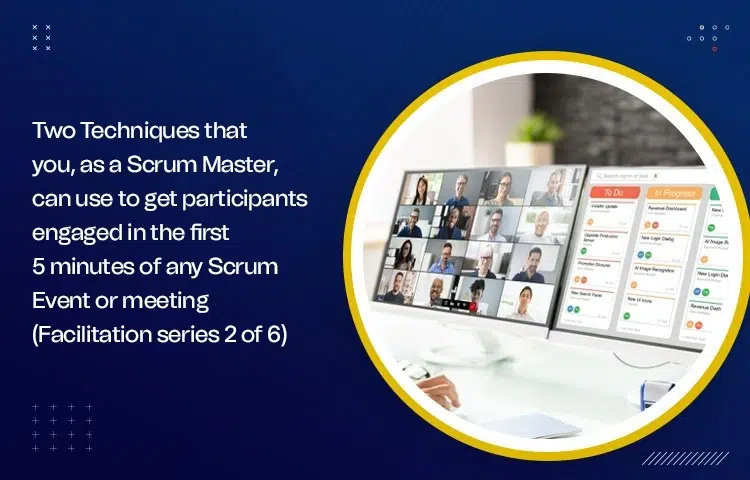Two Techniques that you, as a Scrum Master, can use to get participants engaged in the first 5 minutes of any Scrum Event or meeting (Facilitation series 2 of 6)

- Practitioner
- February 15, 2023
- 6:24 pm
Note: This is Part 2 in the series of blog posts where we will talk about different facilitation techniques. If you haven’t read Part 1, we encourage you to read it first here – What is the most common meeting format, and how you can use that to have effective meetings? Our intention behind writing this series is that once you learn and apply these facilitation techniques, you will witness true collaboration. “True collaboration” means conversations in your meetings lead to new ideas or decisions. In short, the series of blog posts will help you make your meetings more effective.
A successful meeting can only happen with preparation.
Many times Scrum Masters are under the impression that if they are timeboxing the meeting or event, then the meeting or event is bound to meet its objectives. Well, nothing can be farther from the truth.
Well, nothing can be farther from the truth.
You don’t win an Olympic medal by just showing up. It would help if you prepared for it and, most of the time, prepared for years. Thankfully you don’t have to spend years preparing for your next 30 mins meeting. Nevertheless, depending upon what you are trying to achieve, the stakeholders involved, frequency of the meeting, a Scrum Master has to spend some time preparing for the meeting.
It’s Show Time
So, as a Scrum Master, you have prepared for your meeting enough. You have taken care of the logistics as well as supplies.
It is now time to start your meeting.
The very first thing that you do is greet each person individually. If the event happens face to face, you shake each person’s hand. Greeting each person helps establish a connection with the participants and sends a message that you respect each member and value their expertise and wisdom.
Greeting each person is another instance where you practice “Respect”, one of the Scrum values.
Lights, Camera, Action!
To start the meeting, you first ask the team if they are ready to start.
This simple question does lot many things.
- It signals to everyone in the room that the meeting or event is about to start. The question makes the participants aware of a change in their environment. So, they try to drop whatever they are doing and pull their attention to the present.
- It also conveys to the members that they are the ones who are in the driver’s seat.
- You have kickstarted the engagement right at the start.
Ice-breaker or Check-in
The objective here is:-
- To get everyone in the room to talk in the first 5 minutes. Evidence suggests that if participants in the meeting talk in the first 5 minutes, they are more likely to contribute to the rest of the meeting.
- Connect people to the topic of the meeting and how they feel about it or what they know.
- Connect people and establish some trust or relationships in the room.
Let’s talk about two techniques you can use as Ice-breakers or for Check-in in your Scrum events or meetings.
Technique 1. Agreements
This technique sets a tone and expectations near the start of the meeting. This activity also allows you as a Facilitator to create the right atmosphere or culture for the meeting. This technique also helps in creating a shared responsibility.
The output of this technique is that it helps the participants know the boundaries of the meeting and acceptable behaviours.
Here are the steps you can follow to execute this technique and achieve an agreement.
- Go through the agenda of the meeting and then say, “You will park it for a few minutes”.
- Now announce that before we jump in, let’s create agreements to work together effectively.
- Use the following prompts to nudge the participants in coming up with the list of the accords:-
- What atmosphere do you want to have for our session or meeting?
- How do you want to be when we encounter stormy weather?
- What will help to make this session most effective?
Some suggestions for the list of agreements
- Cellphones on silent
- Take care if you have a baby, child, or pet that needs your attention.
- Right to Pass – in case you don’t want to indulge in a discussion.
- Timeboxing – Respect the timeboxes.
Technique 2. Fast Pass
Fast Pass is an incredible technique to use at the start of the meeting. The method provides people who arrive early with something to do.
You can use this technique to connect participants personally or through content related to the meeting.
Here are some suggested questions to connect participants at a personal level:
- What are your pets’ names?
- What is your biggest strength?
- What is one thing that you want the world to know about you?
- Who is that one person that truly inspires you?
Below are some suggested questions to connect participants through content related to the meeting:
- What do you know about < topic of session>?
- Why are you here today?
- What is your greatest challenge with < topic of session>?
- What is one thought that comes to your mind when you think about < topic of session>
Conclusion
As Aristotle said, “Well begun is half done.”. Focusing on starting your meeting using a good check-in or ice-breaker goes a long way in ensuring the success of the meeting. You must pay attention to the Starting phase of the meeting to impress people with how the meeting went or what you achieved out of the meeting.
Try the above techniques and share with us your favourite check-in techniques. Also, please share your experience when you tried any of the above methods.

